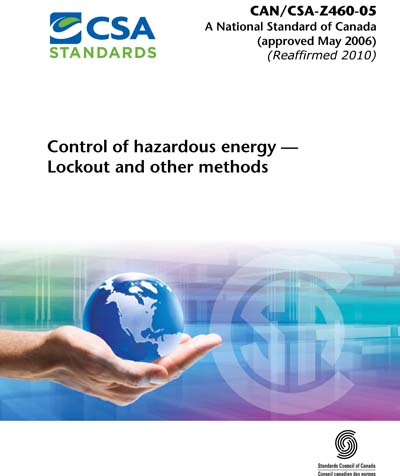Historical
CAN/CSA Z460-2005 (R2010)
CAN/CSA-Z460-05 (R2010) - Control of Hazardous Energy - Lockout and Other Methods
Update #1 was published as notification that this is now a National Standard of Canada
Preface
This is the first edition of CSA Z460, Control of hazardous energy - Lockout and other methods.This Standard specifies requirements for and provides guidance on (a) the responsibilities of the principal parties involved in hazardous energy control (Clause 4); (b) the design issues that influence the effective application of control methodology (Clause 5); (c) task and hazard identification procedures (Clause 6); (d) the hazardous energy control program elements necessary for protection of workers (Clause 7.3); (e) special applications where traditional methods of hazardous energy control are inappropriate or impractical (Clause 7.3.10); (f) development of other methods for tasks that are integral to the production process, including tasks where traditional lockout prohibits completion (Clause 7.4); (g) communication and training (Clause 7.5); and (h) management review to ensure the effective functioning of the hazardous energy control process (Clause 7.6).
1. Scope
1.1 ScopeThis Standard specifies requirements for controlling hazardous energy associated with potentially harmful machines, equipment, or processes. When a CSA Standard or other recognized Standard exists for a specific type of machinery, equipment, or process, it should be used with this Standard to provide the most effective protection.
1.2 Purpose
The purpose of this Standard is to specify requirements and performance objectives for procedures, techniques, designs, and methods to protect personnel from injury from the inadvertent release of hazardous energy. Release of hazardous energy can include any motion, energization, start-up, or release of stored energy that, from the perspective of the person(s) at risk, is either unintended or deliberate. Lockout is recognized as the primary method of hazardous energy control. When the tasks specified in Clause 1.3 are integral to the production process (see Clause 7.4.2), or traditional lockout prohibits completion of those tasks, other methods of control that provide effective personal protection are used. These other methods are based on risk assessment (see Clause 7.4.3).
1.3 Application
This Standard applies, but is not limited to, activities such as erecting, installing, constructing, repairing, adjusting, inspecting, unjamming, setting up, troubleshooting, testing, cleaning, dismantling, servicing, and maintaining machines, equipment, or processes. Safeguarding of machines and the control of energy supply systems during normal production activities are addressed in CSA Z432, the Canadian Electrical Code, Part II, and other machine- and system-specific Standards.
1.4 Exclusions
This Standard does not specify safety procedures for hot tap operations involving transmission and distribution systems for substances such as gas, steam, water, or petroleum products when such operations are performed on pressurized pipelines.
1.5 Terminology
In CSA Standards, "shall" is used to express a requirement, i.e., a provision that the user is obliged to satisfy in order to comply with the standard; "should" is used to express a recommendation or that which is advised but not required; "may" is used to express an option or that which is permissible within the limits of the standard; and "can" is used to express possibility or capability.
Notes accompanying clauses do not include requirements or alternative requirements; the purpose of a note accompanying a clause is to separate from the text explanatory or informative material. Notes to tables and figures are considered part of the table or figure and may be written as requirements. Annexes are designated normative (mandatory) or informative (non-mandatory) to define their application.
Content Provider
CSA America, Inc. [csa]






